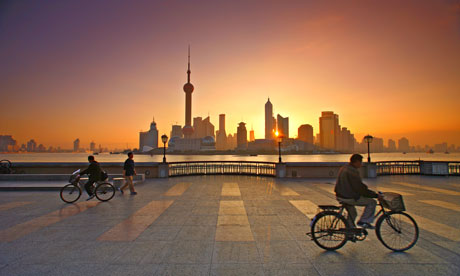 |
| Lin Yong The Spirit of Yan'an Shines Forever, 1971 |
 |
| Modern day China |
Today, there is a convergence of generations affected differently by years of social change, identity loss, democratic activism, and formative events. Contemporary artists have experienced different forms of repression over the decades, from being relocated to "education camps" for their clashing values with those of the State, to having their work censored through the closure of their exhibitions, to even being placed on the Communist Party of China's black list. Due to the hostile environment in which free-thinking artists were brought up in, a variety of art genres have formed, such as cynical realism, political pop, and dissident art.
An example of the dissident artists is Ai Weiwei. He is one of the most influential contemporary artists in China. Ai Weiwei is known for his art which typically goes against the ideas of the government in a loud and blatant manner. Yet he has gained the praise of the government as a talented artist, thus giving him the opportunity to work on the design of the National Stadium showcased for the Beijing Olympics in 2008. More so, he has gained international fame due to his punishment from the Communist Party of China. Such actions have led to his current house arrest, charged on fake claims of tax evasion, and being denied access to the internet and other forms of communication. There is a current worldwide campaign to organize people for his release, visit http://freeaiweiwei.org/ to learn more about Ai Weiwei's detention, future and previous protests held around the globe, and the latest press on Ai Weiwei.
 |
| Ai Weiwei Study of Perspective- Tiananmen Square, 1995-2003 |
A recent work exhibited in the Tate Modern in London titled "Sunflower Seeds", in where 100 million porcelain pieces resembling sunflower seeds filled a gallery spaces floor. Each piece was hand-made in a Chinese town known for making the impeccable porcelain for its Emperors. The piece represents the cumulative power of the people of China, their importance in the party's agenda (its rise to power, the Cultural Revolution, and financial support), simultaneously serving as an analysis on classical Mao Zedong's imagery within political propaganda as the brilliant leader who gave nourishment to the bountiful people of China, represented as sunflower seeds.
Click here to learn more about this.
 |
| Ai Weiwei shown at Tate Modern with the Sunflower Seeds installation. |
 |
| Zhang Xiaogang Bloodline: Three Comrades, 1994 |
 |
| Zhang Xiaogang Bloodline: Big Family No. 2, 1995 |
Another main artist in Contemporary China is Zhang Xiaogang. He is well-known for his "Bloodline: Big Family" and "Comrade" series depicting troubled Chinese families and youth. His style is easily distinguished among artists by his innovative blend of charcoal-like drawings and modern pop art. He has gained international fame due to the over-night demand for his work in the Western world. In 2007, he broke the auction house record at Sotheby's when one of his paintings sold for over two million US dollars.
The "Bloodline: Big Family" series portrays family portraits with the husband, wife, and usually one male child. They are all connected by red lines and noticeable facial traits from both parents. All figures are emotionless, drained of vitality, and simultaneously trapped in time. They have become the iconic image of troubled Chinese families. This series was influenced by Zhang Xiaogang's own family portraits, his upbringing during the 1960's by government officials, and the story of the Cultural Revolution. The Cultural Revolution proved to be a decade of instability, social and political hysteria, and a destructive episode for all traditions and cultural values. It gave way for mass demonstrations by the youth of that time, they closed schools, denounced anyone thought to be counter-revolutionary according to the Communist Party of China. This dark past of China serves as a background for most contemporary Chinese artists.